Opportunities, Technological Challenges and Monitoring Approaches in Agrivoltaic Systems for Sustainable Management
Abstract
1. Introduction
2. Materials and Methods
- Type of publication: classify as research article, review, or conference paper.
- Main focus: sensors, technology, agronomy, spatial analysis. We include any other significant categories found in the dataset.
- Detailed sub-categories: break down the main themes into specific subcategories. Examples of themes include the following areas:
- -
- Social impact (studies addressing social acceptability, community engagement, and workforce implications);
- -
- Environmental impact (includes soil health, biodiversity, water use, etc.);
- -
- Microclimatic factors (humidity, temperature variations, etc.);
- -
- Economic aspects (cost–benefit analyses, market implications, funding sources);
- -
- Agronomic details (yield, crop health, planting methods);
- -
- Technological innovations (hardware and software used, innovative methods);
- -
- Energy efficiency (energy consumption, sustainable practices).
- Scale of analysis: classify into single project case study or global analysis.
- Crop type: catalog specific crops analyzed (e.g., wheat, corn, rice) or, if applicable, multi-crop studies.
- Geographic scope: record the country/state/region where the research was conducted, if provided.
- Publication year: for a chronological perspective.
3. Results
3.1. Bibliographic Analysis
3.1.1. Type of Publication
3.1.2. Main Focus
3.1.3. Detailed Sub-Categories
3.1.4. Scale of Analysis
3.1.5. Crop Type
3.1.6. Journals and Years of Publication
3.2. Technical Analysis
3.3. Agro-Environmental Analysis
3.4. Socio-Economic Analysis
3.5. Monitoring Analysis
4. Conclusions
Author Contributions
Funding
Institutional Review Board Statement
Data Availability Statement
Conflicts of Interest
References
- Turnley, J.W.; Grant, A.; Schull, V.Z.; Cammarano, D.; Sesmero, J.; Agrawal, R. The Viability of Photovoltaics on Agricultural Land: Can PV Solve the Food vs. Fuel Debate? J. Clean. Prod. 2024, 469, 143191. [Google Scholar] [CrossRef]
- Garrod, A.; Hussain, S.N.; Ghosh, A. The Technical and Economic Potential for Crop Based Agrivoltaics in the United Kingdom. Sol. Energy 2024, 277, 112744. [Google Scholar] [CrossRef]
- Kim, B.; Kim, C.; Han, S.U.; Bae, J.H.; Jung, J. Is It a Good Time to Develop Commercial Photovoltaic Systems on Farmland? An American-Style Option with Crop Price Risk. Renew. Sustain. Energy Rev. 2020, 125, 109827. [Google Scholar] [CrossRef]
- Abidin, M.A.Z.; Mahyuddin, M.N.; Zainuri, M.A.A.M. Solar Photovoltaic Architecture and Agronomic Management in Agrivoltaic System: A Review. Sustainability 2021, 13, 7846. [Google Scholar] [CrossRef]
- Zhang, L.; Yang, Z.; Wu, X.; Wang, W.; Yang, C.; Xu, G.; Wu, C.; Bao, E. Open-Field Agrivoltaic System Impacts on Photothermal Environment and Light Environment Simulation Analysis in Eastern China. Agronomy 2023, 13, 1820. [Google Scholar] [CrossRef]
- Chopdar, R.K.; Sengar, N.; Giri, N.C.; Halliday, D. Comprehensive Review on Agrivoltaics with Technical, Environmental and Societal Insights. Renew. Sustain. Energy Rev. 2024, 197, 114416. [Google Scholar] [CrossRef]
- Martínez, M.V.; de Ahumada, L.M.F.; García, M.F.; García, P.F.; de la Torre, F.C.; López-Luque, R. Characterization of an Experimental Agrivoltaic Installation Located in a Educational Centre for Farmers in Cordoba (Spain). Renew. Energy Power Qual. J. 2022, 20, 111–115. [Google Scholar] [CrossRef]
- Arena, R.; Aneli, S.; Gagliano, A.; Tina, G.M. Optimal Photovoltaic Array Layout of Agrivoltaic Systems Based on Vertical Bifacial Photovoltaic Modules. Sol. RRL 2024, 8, 2300505. [Google Scholar] [CrossRef]
- Sarr, A.; Soro, Y.M.; Tossa, A.K.; Diop, L. Agrivoltaic, a Synergistic Co-Location of Agricultural and Energy Production in Perpetual Mutation: A Comprehensive Review. Processes 2023, 11, 948. [Google Scholar] [CrossRef]
- Al Ali, A.; El-Keblawy, A.; Zhang, D.; Tabet, N. Use of Agrivoltaics to Enhance Cucumber Production in the Hot and Arid Climate of UAE: A Sustainable Approach for Food and Clean Energy Security. In Proceedings of the 2023 Middle East and North Africa Solar Conference, MENA-SC 2023-Proceedings, Dubai, United Arab Emirates, 15–18 November 2023; Institute of Electrical and Electronics Engineers Inc.: Piscataway, NJ, USA, 2023. [Google Scholar]
- Warmann, E.; Jenerette, G.D.; Barron-Gafford, G.A. Agrivoltaic System Design Tools for Managing Trade-Offs between Energy Production, Crop Productivity and Water Consumption. Environ. Res. Lett. 2024, 19, 034046. [Google Scholar] [CrossRef]
- Maity, R.; Sudhakar, K.; Abdul Razak, A.; Karthick, A.; Barbulescu, D. Agrivoltaic: A Strategic Assessment Using SWOT and TOWS Matrix. Energies 2023, 16, 3313. [Google Scholar] [CrossRef]
- Xue, J. Photovoltaic Agriculture-New Opportunity for Photovoltaic Applications in China. Renew. Sustain. Energy Rev. 2017, 73, 1–9. [Google Scholar] [CrossRef]
- Giri, N.C.; Mohanty, R.C. Agrivoltaic System: Experimental Analysis for Enhancing Land Productivity and Revenue of Farmers. Energy Sustain. Dev. 2022, 70, 54–61. [Google Scholar] [CrossRef]
- Macdonald, J.; Roca-Cladera, J. Photovoltaic + Photosynthetic Coexistence: Towards a Sensible Accelerated Mass Integration of PV Onto a Perturbed Planet. Archit. City Environ. 2024, 18, 12118. [Google Scholar] [CrossRef]
- Ferreira, R.F.; Marques Lameirinhas, R.A.; Bernardo, C.P.C.V.; João, J.P.; Santos, M. Agri-PV in Portugal: How to Combine Agriculture and Photovoltaic Production. Energy Sustain. Dev. 2024, 79, 101408. [Google Scholar] [CrossRef]
- Fattoruso, G.; Toscano, D.; Venturo, A.; Scognamiglio, A.; Fabricino, M.; Di Francia, G. A Spatial Multicriteria Analysis for a Regional Assessment of Eligible Areas for Sustainable Agrivoltaic Systems in Italy. Sustainability 2024, 16, 911. [Google Scholar] [CrossRef]
- Ayadi, O.; Al-Bakri, J.T.; Abdalla, M.E.B.; Aburumman, Q. The Potential of Agrivoltaic Systems in Jordan. Appl. Energy 2024, 372, 123841. [Google Scholar] [CrossRef]
- Coşgun, A.E.; Endiz, M.S.; Demir, H.; Özcan, M. Agrivoltaic Systems for Sustainable Energy and Agriculture Integration in Turkey. Heliyon 2024, 10, e32300. [Google Scholar] [CrossRef] [PubMed]
- Jing, R.; He, Y.; He, J.; Liu, Y.; Yang, S. Global Sensitivity Based Prioritizing the Parametric Uncertainties in Economic Analysis When Co-Locating Photovoltaic with Agriculture and Aquaculture in China. Renew. Energy 2022, 194, 1048–1059. [Google Scholar] [CrossRef]
- Ruelas, J.; Muñoz, F.; Palomares, J.; Castro, J. A Dataset for Photovoltaic Energy Potential of the Yaqui Valley, Sonora, México. Data Brief. 2024, 52, 109983. [Google Scholar] [CrossRef]
- Lama, R.K.; Jeong, H. Design and Performance Analysis of Foldable Solar Panel for Agrivoltaics System. Sensors 2024, 24, 1167. [Google Scholar] [CrossRef]
- Zainali, S.; Qadir, O.; Parlak, S.C.; Lu, S.M.; Avelin, A.; Stridh, B.; Campana, P.E. Computational Fluid Dynamics Modelling of Microclimate for a Vertical Agrivoltaic System. Energy Nexus 2023, 9, 100173. [Google Scholar] [CrossRef]
- Casares de la Torre, F.J.; Varo-Martinez, M.; López-Luque, R.; Ramírez-Faz, J.; Fernández-Ahumada, L.M. Design and Analysis of a Tracking / Backtracking Strategy for PV Plants with Horizontal Trackers after Their Conversion to Agrivoltaic Plants. Renew. Energy 2022, 187, 537–550. [Google Scholar] [CrossRef]
- Vandewetering, N.; Hayibo, K.S.; Pearce, J.M. Open-Source Vertical Swinging Wood-Based Solar Photovoltaic Racking Systems. Designs 2023, 7, 34. [Google Scholar] [CrossRef]
- Toledo, C.; Scognamiglio, A. Agrivoltaic Systems Design and Assessment: A Critical Review, and a Descriptive Model towards a Sustainable Landscape Vision (Three-Dimensional Agrivoltaic Patterns). Sustainability 2021, 13, 6871. [Google Scholar] [CrossRef]
- Campana, P.E.; Stridh, B.; Amaducci, S.; Colauzzi, M. Optimisation of Vertically Mounted Agrivoltaic Systems. J. Clean. Prod. 2021, 325, 129091. [Google Scholar] [CrossRef]
- Pearce, J.M.; Parametric, J. Parametric Open Source Cold-Frame Agrivoltaic Systems. Inventions 2021, 6, 71. [Google Scholar] [CrossRef]
- Leon, A.; Ishihara, K.N. Influence of Allocation Methods on the LC-CO2 Emission of an Agrivoltaic System. Resour. Conserv. Recycl. 2018, 138, 110–117. [Google Scholar] [CrossRef]
- Riaz, M.H.; Imran, H.; Younas, R.; Butt, N.Z. The Optimization of Vertical Bifacial Photovoltaic Farms for Efficient Agrivoltaic Systems. Sol. Energy 2021, 230, 1004–1012. [Google Scholar] [CrossRef]
- Botero-Valencia, J.S.; Mejia-Herrera, M.; Pearce, J.M. Low Cost Climate Station for Smart Agriculture Applications with Photovoltaic Energy and Wireless Communication. HardwareX 2022, 11, e00296. [Google Scholar] [CrossRef]
- Huang, K.; Shu, L.; Li, K.; Chen, Y.; Zhu, Y.; Valluru, R. Sustainable and Intelligent Phytoprotection in Photovoltaic Agriculture: New Challenges and Opportunities. Electronics 2023, 12, 1221. [Google Scholar] [CrossRef]
- Shatar, N.M.; Azizi, M.; Rahman, A.; Zaki, A.; Salim, S.; Hatta, M.; Ariff, M.; Muhtazaruddin, M.N.; Kamil, A.; Badlisah, A. Design of Photovoltaic-Thermoelectric Generator (PV-TEG) Hybrid System for Precision Agriculture. In Proceedings of the 2018 IEEE 7th International Conference on Power and Energy (PECon), Kuala Lumpur, Malaysia, 3–4 December 2018. [Google Scholar]
- Zainali, S.; Ma Lu, S.; Stridh, B.; Avelin, A.; Amaducci, S.; Colauzzi, M.; Campana, P.E. Direct and Diffuse Shading Factors Modelling for the Most Representative Agrivoltaic System Layouts. Appl. Energy 2023, 339, 120981. [Google Scholar] [CrossRef]
- Ma Lu, S.; Zainali, S.; Stridh, B.; Avelin, A.; Amaducci, S.; Colauzzi, M.; Campana, P.E. Photosynthetically Active Radiation Decomposition Models for Agrivoltaic Systems Applications. Sol. Energy 2022, 244, 536–549. [Google Scholar] [CrossRef]
- Widmer, J.; Christ, B.; Grenz, J.; Norgrove, L. Agrivoltaics, a Promising New Tool for Electricity and Food Production: A Systematic Review. Renew. Sustain. Energy Rev. 2024, 192, 114277. [Google Scholar] [CrossRef]
- Farghally, H.M.; Sweelem, E.A.; Abu El-Sebah, M.I.; Syam, F.A. Agricultural Grid Connected Photovoltaic System Design and Simulation in Egypt by Using PVSYST Software. WSEAS Trans. Circuits Syst. 2022, 21, 306–315. [Google Scholar] [CrossRef]
- Choi, C.S.; Macknick, J.; Li, Y.; Bloom, D.; McCall, J.; Ravi, S. Environmental Co-Benefits of Maintaining Native Vegetation With Solar Photovoltaic Infrastructure. Earths Future 2023, 11, e2023EF003542. [Google Scholar] [CrossRef]
- Dal Prà, A.; Miglietta, F.; Genesio, L.; Lanini, G.M.; Bozzi, R.; Morè, N.; Greco, A.; Fabbri, M.C. Determination of Feed Yield and Quality Parameters of Whole Crop Durum Wheat (Triticum durum Desf.) Biomass under Agrivoltaic System. Agrofor. Syst. 2024, 98, 2861–2873. [Google Scholar] [CrossRef]
- Taylor, M.; Pettit, J.; Sekiyama, T.; Sokołowski, M.M. Justice-Driven Agrivoltaics: Facilitating Agrivoltaics Embedded in Energy Justice. Renew. Sustain. Energy Rev. 2023, 188, 113815. [Google Scholar] [CrossRef]
- Jamil, U.; Pearce, J.M. Maximizing Biomass with Agrivoltaics: Potential and Policy in Saskatchewan Canada. Biomass 2023, 3, 188–216. [Google Scholar] [CrossRef]
- Vidotto, L.C.; Schneider, K.; Morato, R.W.; do Nascimento, L.R.; Rüther, R. An Evaluation of the Potential of Agrivoltaic Systems in Brazil. Appl. Energy 2024, 360, 122782. [Google Scholar] [CrossRef]
- Adomavicius, V. Review of Results of Agro-Photovoltaic System Implementation in Agriculture. In Proceedings of the Engineering for Rural Development, Jelgava, Latvia, 26−28 May 2021; Latvia University of Life Sciences and Technologies: Jelgava, Latvia, 2021; Volume 20, pp. 605–610. [Google Scholar]
- Alyasjeen, S.; Elbeheiry, N.; Shukri, S.; Balog, R.S. Open-Platform Sensor Node for Agrivoltaics. In Proceedings of the 2023 IEEE Texas Power and Energy Conference, TPEC 2023, College Station, TX, USA, 13–14 February 2023; Institute of Electrical and Electronics Engineers Inc.: Piscataway, NJ, USA, 2023. [Google Scholar]
- Sturchio, M.A.; Kannenberg, S.A.; Knapp, A.K. Agrivoltaic Arrays Can Maintain Semi-Arid Grassland Productivity and Extend the Seasonality of Forage Quality. Appl. Energy 2024, 356, 122418. [Google Scholar] [CrossRef]
- Li, Z.; Sun, X.; Zhou, J.; Wu, L.; Bi, D.; Zhao, J.; Zhu, R.; Christie, P. Sustainable Phytoextraction of Metal-Polluted Agricultural Land Used for Commercial Photovoltaic Power Generation. J. Clean. Prod. 2023, 391, 136093. [Google Scholar] [CrossRef]
- Teng, J.W.C.; Soh, C.B.; Devihosur, S.C.; Tay, R.H.S.; Jusuf, S.K. Effects of Agrivoltaic Systems on the Surrounding Rooftop Microclimate. Sustainability 2022, 14, 7089. [Google Scholar] [CrossRef]
- Willockx, B.; Lavaert, C.; Cappelle, J. Performance Evaluation of Vertical Bifacial and Single-Axis Tracked Agrivoltaic Systems on Arable Land. Renew. Energy 2023, 217, 119181. [Google Scholar] [CrossRef]
- Dupraz, C.; Marrou, H.; Talbot, G.; Dufour, L.; Nogier, A.; Ferard, Y. Combining Solar Photovoltaic Panels and Food Crops for Optimising Land Use: Towards New Agrivoltaic Schemes. Renew. Energy 2011, 36, 2725–2732. [Google Scholar] [CrossRef]
- Torrente, C.J.; Reca, J.; López-Luque, R.; Martínez, J.; Casares, F.J. Simulation Model to Analyze the Spatial Distribution of Solar Radiation in Agrivoltaic Mediterranean Greenhouses and Its Effect on Crop Water Needs. Appl. Energy 2024, 353, 122050. [Google Scholar] [CrossRef]
- Riaz, M.H.; Imran, H.; Butt, N.Z. Optimization of PV Array Density for Fixed Tilt Bifacial Solar Panels for Efficient Agrivoltaic Systems. In Proceedings of the Conference Record of the IEEE Photovoltaic Specialists Conference, Calgary, AB, Canada, 15 June 2020–21 August 2020; Institute of Electrical and Electronics Engineers Inc.: Piscataway, NJ, USA, 2020; Volume 2020-June, pp. 1349–1352. [Google Scholar]
- Elkadeem, M.R.; Zainali, S.; Lu, S.M.; Younes, A.; Abido, M.A.; Amaducci, S.; Croci, M.; Zhang, J.; Landelius, T.; Stridh, B.; et al. Agrivoltaic Systems Potentials in Sweden: A Geospatial-Assisted Multi-Criteria Analysis. Appl. Energy 2024, 356, 122108. [Google Scholar] [CrossRef]
- Chae, S.H.; Kim, H.J.; Moon, H.W.; Kim, Y.H.; Ku, K.M. Agrivoltaic Systems Enhance Farmers’ Profits through Broccoli Visual Quality and Electricity Production without Dramatic Changes in Yield, Antioxidant Capacity, and Glucosinolates. Agronomy 2022, 12, 1415. [Google Scholar] [CrossRef]
- Grubbs, E.K.; Gruss, S.M.; Schull, V.Z.; Gosney, M.J.; Mickelbart, M.V.; Brouder, S.; Gitau, M.W.; Bermel, P.; Tuinstra, M.R.; Agrawal, R. Optimized Agrivoltaic Tracking for Nearly-Full Commodity Crop and Energy Production. Renew. Sustain. Energy Rev. 2024, 191, 114018. [Google Scholar] [CrossRef]
- Varo-Martínez, M.; Fernández-Ahumada, L.M.; Ramírez-Faz, J.C.; Ruiz-Jiménez, R.; López-Luque, R. Methodology for the Estimation of Cultivable Space in Photovoltaic Installations with Dual-Axis Trackers for Their Reconversion to Agrivoltaic Plants. Appl. Energy 2024, 361, 122952. [Google Scholar] [CrossRef]
- Agostini, A.; Colauzzi, M.; Amaducci, S. Innovative Agrivoltaic Systems to Produce Sustainable Energy: An Economic and Environmental Assessment. Appl. Energy 2021, 281, 116102. [Google Scholar] [CrossRef]
- Rampinelli, G.A.; Marcelino, R.; Possenti Damasceno, J.; Caroline Stalter, C.; Bouchardet, A.T.R.; Mohr, G.; Guber, V. Development of Artificial Lighting System for Light Supplementation in Smart Greenhouses with Agrivoltaic Systems. Renew. Energy 2024, 231, 120914. [Google Scholar] [CrossRef]
- Gnayem, N.; Magadley, E.; Haj-Yahya, A.; Masalha, S.; Kabha, R.; Abasi, A.; Barhom, H.; Matar, M.; Attrash, M.; Yehia, I. Examining the Effect of Different Photovoltaic Modules on Cucumber Crops in a Greenhouse Agrivoltaic System: A Case Study. Biosyst. Eng. 2024, 241, 83–94. [Google Scholar] [CrossRef]
- Petrakis, T.; Ioannou, P.; Kitsiou, F.; Kavga, A.; Grammatikopoulos, G.; Karamanos, N. Growth and Physiological Characteristics of Strawberry Plants Cultivated under Greenhouse-Integrated Semi-Transparent Photovoltaics. Plants 2024, 13, 768. [Google Scholar] [CrossRef] [PubMed]
- Song, W.; Ge, J.; Xie, L.; Chen, Z.; Ye, Q.; Sun, D.; Shi, J.; Tong, X.; Zhang, X.; Ge, Z. Semi-Transparent Organic Photovoltaics for Agrivoltaic Applications. Nano Energy 2023, 116, 108805. [Google Scholar] [CrossRef]
- Stallknecht, E.J.; Herrera, C.K.; Yang, C.; King, I.; Sharkey, T.D.; Lunt, R.R.; Runkle, E.S. Designing Plant–Transparent Agrivoltaics. Sci. Rep. 2023, 13, 1903. [Google Scholar] [CrossRef]
- Li, H.; Sun, S. Exploration of the European Agrivoltaics Landscape in the Context of Global Climate Change. In Proceedings of the E3S Web of Conferences, Barcelona, Spain, 3 May 2024; EDP Sciences: Les Ulis, France, 2024; Volume 520. [Google Scholar]
- Ghaffarpour, Z.; Fakhroleslam, M.; Amidpour, M. Calculation of Energy Consumption, Tomato Yield, and Electricity Generation in a PV-Integrated Greenhouse with Different Solar Panels Configuration. Renew. Energy 2024, 229, 120723. [Google Scholar] [CrossRef]
- Wu, G.; Fang, H.; Zhang, Y.; Li, K.; Xu, D. Photothermal and Photovoltaic Utilization for Improving the Thermal Environment of Chinese Solar Greenhouses: A Review. Energies 2023, 16, 6816. [Google Scholar] [CrossRef]
- Camporese, M.; Abou Najm, M. Not All Light Spectra Were Created Equal: Can We Harvest Light for Optimum Food-Energy Co-Generation? Earths Future 2022, 10, e2022EF002900. [Google Scholar] [CrossRef]
- Kuaban, G.S.; Czekalski, P.; Nwobodo, O.J.; Sell, R.; Nikitenko, A.; Berkolds, K.; Tanko, K.T. Smart Sustainable Agrivoltaics Systems: The Future of Sustainable Agricultural Technology (Agri-Tech) and Green Energy. In Proceedings of the International Conference on Electrical, Computer, Communications and Mechatronics Engineering, ICECCME 2023, Tenerife, Spain, 19–21 July 2023; Institute of Electrical and Electronics Engineers Inc.: Piscataway, NJ, USA, 2023. [Google Scholar]
- Alafnan, H. The Impact of PV Panel Degradation Rate, Initial System Efficiency, and Interest Rate on the Levelized Cost of Energy for PV Projects: Saudi Arabia as a Benchmark. Sustainability 2024, 16, 10012. [Google Scholar] [CrossRef]
- Pramanick, D.; Kumar, J. Performance and Degradation Assessment of Two Different Solar PV Cell Technologies in the Remote Region of Eastern India. e-Prime-Adv. Electr. Eng. Electron. Energy 2024, 7, 100432. [Google Scholar] [CrossRef]
- Feng, F.; Hu, Z.; Wang, J.; Wang, P.; Sun, C.; Wang, X.; Bi, F.; Li, Y.; Bao, X. Non-Fused π-Extension of Endcaps of Small Molecular Acceptors Enabling High-Performance Organic Solar Cells. ChemSusChem 2024, 17, e202400601. [Google Scholar] [CrossRef] [PubMed]
- Walshe, J.; Carron, P.M.; McCormack, S.; Doran, J.; Amarandei, G. Organic Luminescent Down-Shifting Liquid Beam Splitters for Hybrid Photovoltaic-Thermal (PVT) Applications. Sol. Energy Mater. Sol. Cells 2021, 219, 110818. [Google Scholar] [CrossRef]
- Othman, N.F.; Ya’acob, M.E.; Lu, L.; Jamaluddin, A.H.; Mat Su, A.S.; Hizam, H.; Shamsudin, R.; Jaafar, J.N. Advancement in Agriculture Approaches with Agrivoltaics Natural Cooling in Large Scale Solar PV Farms. Agriculture 2023, 13, 854. [Google Scholar] [CrossRef]
- Choi, C.S.; Macknick, J.; McCall, J.; Bertel, R.; Ravi, S. Multi-Year Analysis of Physical Interactions between Solar PV Arrays and Underlying Soil-Plant Complex in Vegetated Utility-Scale Systems. Appl. Energy 2024, 365, 123227. [Google Scholar] [CrossRef]
- Kazem, H.A.; Al-Waeli, A.H.A.; Chaichan, M.T.; Sopian, K.; Al Busaidi, A.S.; Gholami, A. Photovoltaic-Thermal Systems Applications as Dryer for Agriculture Sector: A Review. Case Stud. Therm. Eng. 2023, 47, 103047. [Google Scholar] [CrossRef]
- Leon, A.; Ishihara, K.N. Assessment of New Functional Units for Agrivoltaic Systems. J. Environ. Manag. 2018, 226, 493–498. [Google Scholar] [CrossRef] [PubMed]
- Patel, U.R.; Gadhiya, G.A.; Chauhan, P.M. Techno-Economic Analysis of Agrivoltaic System for Affordable and Clean Energy with Food Production in India. Clean. Technol. Environ. Policy 2024, 26, 2117–2135. [Google Scholar] [CrossRef]
- Al-Agele, H.A.; Proctor, K.; Murthy, G.; Higgins, C. A Case Study of Tomato (Solanum Lycopersicon Var. Legend) Production and Water Productivity in Agrivoltaic Systems. Sustainability 2021, 13, 2850. [Google Scholar] [CrossRef]
- Gonocruz, R.A.; Nakamura, R.; Yoshino, K.; Homma, M.; Doi, T.; Yoshida, Y.; Tani, A. Analysis of the Rice Yield under an Agrivoltaic System: A Case Study in Japan. Environments 2021, 8, 65. [Google Scholar] [CrossRef]
- Kim, S.; Kim, S.; An, K. An Integrated Multi-Modeling Framework to Estimate Potential Rice and Energy Production under an Agrivoltaic System. Comput. Electron. Agric. 2023, 213, 108157. [Google Scholar] [CrossRef]
- Sojib Ahmed, M.; Rezwan Khan, M.; Haque, A.; Ryyan Khan, M. Agrivoltaics Analysis in a Techno-Economic Framework: Understanding Why Agrivoltaics on Rice Will Always Be Profitable. Appl. Energy 2022, 323, 119560. [Google Scholar] [CrossRef]
- Giudice, B.D.; Stillinger, C.; Chapman, E.; Martin, M.; Riihimaki, B. Residential Agrivoltaics: Energy Efficiency and Water Conservation in the Urban Landscape. In Proceedings of the IEEE Green Technologies Conference, Denver, CO, USA, 7–9 April 2021; IEEE Computer Society: Washington, DC, USA, 2021; Volume 2021-April, pp. 237–244. [Google Scholar]
- Elamri, Y.; Cheviron, B.; Lopez, J.M.; Dejean, C.; Belaud, G. Water Budget and Crop Modelling for Agrivoltaic Systems: Application to Irrigated Lettuces. Agric. Water Manag. 2018, 208, 440–453. [Google Scholar] [CrossRef]
- Malu, P.R.; Sharma, U.S.; Pearce, J.M. Agrivoltaic Potential on Grape Farms in India. Sustain. Energy Technol. Assess. 2017, 23, 104–110. [Google Scholar] [CrossRef]
- Cho, J.; Park, S.M.; Reum Park, A.; Lee, O.C.; Nam, G.; Ra, I.H. Application of Photovoltaic Systems for Agriculture: A Study on the Relationship between Power Generation and Farming for the Improvement of Photovoltaic Applications in Agriculture. Energies 2020, 13, 4815. [Google Scholar] [CrossRef]
- Al Mamun, M.A.; Dargusch, P.; Wadley, D.; Zulkarnain, N.A.; Aziz, A.A. A Review of Research on Agrivoltaic Systems. Renew. Sustain. Energy Rev. 2022, 161, 112351. [Google Scholar] [CrossRef]
- Magarelli, A.; Mazzeo, A.; Ferrara, G. Fruit Crop Species with Agrivoltaic Systems: A Critical Review. Agronomy 2024, 14, 722. [Google Scholar] [CrossRef]
- Weselek, A.; Bauerle, A.; Hartung, J.; Zikeli, S.; Lewandowski, I.; Högy, P. Agrivoltaic System Impacts on Microclimate and Yield of Different Crops within an Organic Crop Rotation in a Temperate Climate. Agron. Sustain. Dev. 2021, 41, 59. [Google Scholar] [CrossRef]
- Santos, A.A.; Pereira, F.; da Silva, A.F.; Caetano, N.; Felgueiras, C.; Machado, J. Electrification of a Remote Rural Farm with Solar Energy—Contribution to the Development of Smart Farming. Energies 2023, 16, 7706. [Google Scholar] [CrossRef]
- Sturchio, M.A.; Kannenberg, S.A.; Pinkowitz, T.A.; Knapp, A.K. Solar Arrays Create Novel Environments That Uniquely Alter Plant Responses. Plants People Planet. 2024, 6, 1522–1533. [Google Scholar] [CrossRef]
- Ya’acob, M.E.; Lu, L.; Zulkifli, S.A.; Roslan, N.; Ahmad, W.F.H.W. Agrivoltaic Approach in Improving Soil Resistivity in Large Scale Solar Farms for Energy Sustainability. Appl. Energy 2023, 352, 121943. [Google Scholar] [CrossRef]
- Akbar, A.; Mahmood, F.I.; Alam, H.; Aziz, F.; Bashir, K.; Zafar Butt, N. Field Assessment of Vertical Bifacial Agrivoltaics with Vegetable Production: A Case Study in Lahore, Pakistan. Renew. Energy 2024, 227, 120513. [Google Scholar] [CrossRef]
- Xia, Z.; Li, Y.; Guo, S.; Jia, N.; Pan, X.; Mu, H.; Chen, R.; Guo, M.; Du, P. Balancing Photovoltaic Development and Cropland Protection: Assessing Agrivoltaic Potential in China. Sustain. Prod. Consum. 2024, 50, 205–215. [Google Scholar] [CrossRef]
- Asa’a, S.; Reher, T.; Rongé, J.; Diels, J.; Poortmans, J.; Radhakrishnan, H.S.; van der Heide, A.; Van de Poel, B.; Daenen, M. A Multidisciplinary View on Agrivoltaics: Future of Energy and Agriculture. Renew. Sustain. Energy Rev. 2024, 200, 114515. [Google Scholar] [CrossRef]
- Alhajeri, N.S.; Al-Fadhli, F.M.; Deshpande, A.A.; El-Halwagi, M.M. Optimization of Water-Energy-Food Nexus via an Integrated System of Solar-Assisted Desalination and Farming. J. Clean. Prod. 2024, 434, 140362. [Google Scholar] [CrossRef]
- Jamil, U.; Bonnington, A.; Pearce, J.M. The Agrivoltaic Potential of Canada. Sustainability 2023, 15, 3228. [Google Scholar] [CrossRef]
- Campana, P.E.; Stridh, B.; Hörndahl, T.; Svensson, S.E.; Zainali, S.; Lu, S.M.; Zidane, T.E.K.; De Luca, P.; Amaducci, S.; Colauzzi, M. Experimental Results, Integrated Model Validation, and Economic Aspects of Agrivoltaic Systems at Northern Latitudes. J. Clean. Prod. 2024, 437, 140235. [Google Scholar] [CrossRef]
- Kim, S.; Kim, S. Design of an Agrivoltaic System with Building Integrated Photovoltaics. Agronomy 2023, 13, 2140. [Google Scholar] [CrossRef]
- Di Francia, G.; Cupo, P. A Cost–Benefit Analysis for Utility-Scale Agrivoltaic Implementation in Italy. Energies 2023, 16, 2991. [Google Scholar] [CrossRef]
- Coşgun, A.E. The Potential of Agrivoltaic Systems in TURKEY. Energy Rep. 2021, 7, 105–111. [Google Scholar] [CrossRef]
- Ko, D.Y.; Chae, S.H.; Moon, H.W.; Kim, H.J.; Seong, J.; Lee, M.S.; Ku, K.M. Agrivoltaic Farming Insights: A Case Study on the Cultivation and Quality of Kimchi Cabbage and Garlic. Agronomy 2023, 13, 2625. [Google Scholar] [CrossRef]
- Giri, N.C.; Mohanty, R.C. Design of Agrivoltaic System to Optimize Land Use for Clean Energy-Food Production: A Socio-Economic and Environmental Assessment. Clean. Technol. Environ. Policy 2022, 24, 2595–2606. [Google Scholar] [CrossRef]
- Trommsdorff, M.; Kang, J.; Reise, C.; Schindele, S.; Bopp, G.; Ehmann, A.; Weselek, A.; Högy, P.; Obergfell, T. Combining Food and Energy Production: Design of an Agrivoltaic System Applied in Arable and Vegetable Farming in Germany. Renew. Sustain. Energy Rev. 2021, 140, 110694. [Google Scholar] [CrossRef]
- Chalgynbayeva, A.; Mizik, T.; Bai, A. Cost–Benefit Analysis of Kaposvár Solar Photovoltaic Park Considering Agrivoltaic Systems. Clean. Technol. 2022, 4, 1054–1070. [Google Scholar] [CrossRef]
- Huang, K.; Shu, L.; Li, K.; Yang, F.; Han, G.; Wang, X.; Pearson, S. Photovoltaic Agricultural Internet of Things towards Realizing the next Generation of Smart Farming. IEEE Access 2020, 8, 76300–76312. [Google Scholar] [CrossRef]
- Willockx, B.; Reher, T.; Lavaert, C.; Herteleer, B.; Van de Poel, B.; Cappelle, J. Design and Evaluation of an Agrivoltaic System for a Pear Orchard. Appl. Energy 2024, 353, 122166. [Google Scholar] [CrossRef]
- Mouhib, E.; Fernández-Solas, Á.; Pérez-Higueras, P.J.; Fernández-Ocaña, A.M.; Micheli, L.; Almonacid, F.; Fernández, E.F. Enhancing Land Use: Integrating Bifacial PV and Olive Trees in Agrivoltaic Systems. Appl. Energy 2024, 359, 122660. [Google Scholar] [CrossRef]
- Dinesh, H.; Pearce, J.M. The Potential of Agrivoltaic Systems. Renew. Sustain. Energy Rev. 2016, 54, 299–308. [Google Scholar] [CrossRef]
- Chirinda, N.; De Ruijter, F.; Walston, L.J. Opportunities for Agrivoltaic Systems to Achieve Synergistic Food-Energy-Environmental Needs and Address Sustainability Goals. Front. Sustain. Food Syst. 2022, 6, 932018. [Google Scholar]
- Hermelink, M.I.; Maestrini, B.; de Ruijter, F.J. Berry Shade Tolerance for Agrivoltaics Systems: A Meta-Analysis. Sci. Hortic. 2024, 330, 113062. [Google Scholar] [CrossRef]
- Weselek, A.; Bauerle, A.; Zikeli, S.; Lewandowski, I.; Högy, P. Effects on Crop Development, Yields and Chemical Composition of Celeriac (Apium graveolens L. Var. Rapaceum) Cultivated underneath an Agrivoltaic System. Agronomy 2021, 11, 733. [Google Scholar] [CrossRef]
- Potenza, E.; Croci, M.; Colauzzi, M.; Amaducci, S. Agrivoltaic System and Modelling Simulation: A Case Study of Soybean (Glycine max L.) in Italy. Horticulturae 2022, 8, 1160. [Google Scholar] [CrossRef]
- Ghosh, A. Nexus between Agriculture and Photovoltaics (Agrivoltaics, Agriphotovoltaics) for Sustainable Development Goal: A Review. Sol. Energy 2023, 266, 112146. [Google Scholar] [CrossRef]
- Faria, A.F.P.A.; Maia, A.S.C.; Moura, G.A.B.; Fonsêca, V.F.C.; Nascimento, S.T.; Milan, H.F.M.; Gebremedhin, K.G. Use of Solar Panels for Shade for Holstein Heifers. Animals 2023, 13, 329. [Google Scholar] [CrossRef]
- Matulić, D.; Andabaka, Ž.; Radman, S.; Fruk, G.; Leto, J.; Rošin, J.; Rastija, M.; Varga, I.; Tomljanović, T.; Čeprnja, H.; et al. Agrivoltaics and Aquavoltaics: Potential of Solar Energy Use in Agriculture and Freshwater Aquaculture in Croatia. Agriculture 2023, 13, 1447. [Google Scholar] [CrossRef]
- Pascaris, A.S.; Handler, R.; Schelly, C.; Pearce, J.M. Life Cycle Assessment of Pasture-Based Agrivoltaic Systems: Emissions and Energy Use of Integrated Rabbit Production. Clean. Responsible Consum. 2021, 3, 100030. [Google Scholar] [CrossRef]
- Lytle, W.; Meyer, T.K.; Tanikella, N.G.; Burnham, L.; Engel, J.; Schelly, C.; Pearce, J.M. Conceptual Design and Rationale for a New Agrivoltaics Concept: Pasture-Raised Rabbits and Solar Farming. J. Clean. Prod. 2021, 282, 124476. [Google Scholar] [CrossRef]
- Ali Abaker Omer, A.; Liu, W.; Li, M.; Zheng, J.; Zhang, F.; Zhang, X.; Osman Hamid Mohammed, S.; Fan, L.; Liu, Z.; Chen, F.; et al. Water Evaporation Reduction by the Agrivoltaic Systems Development. Sol. Energy 2022, 247, 13–23. [Google Scholar] [CrossRef]
- Panda, S.; Kumar, R.; Panda, B.; Panda, B.; Raj, A. Combining Solar Panels with Plants for Sustainable Energy and Food Production: State of the Art. Int. J. Appl. Power Eng. 2024, 13, 434–441. [Google Scholar] [CrossRef]
- Gorjian, S.; Bousi, E.; Özdemir, Ö.E.; Trommsdorff, M.; Kumar, N.M.; Anand, A.; Kant, K.; Chopra, S.S. Progress and Challenges of Crop Production and Electricity Generation in Agrivoltaic Systems Using Semi-Transparent Photovoltaic Technology. Renew. Sustain. Energy Rev. 2022, 158, 112126. [Google Scholar] [CrossRef]
- Othman, N.F.; Yaacob, M.E.; Su, A.S.M.; Jaafar, J.N.; Hizam, H.; Shahidan, M.F.; Jamaluddin, A.H.; Chen, G.; Jalaludin, A. Modeling of Stochastic Temperature and Heat Stress Directly underneath Agrivoltaic Conditions with Orthosiphon Stamineus Crop Cultivation. Agronomy 2020, 10, 1472. [Google Scholar] [CrossRef]
- Agir, S.; Derin-Gure, P.; Senturk, B. Farmers’ Perspectives on Challenges and Opportunities of Agrivoltaics in Turkiye: An Institutional Perspective. Renew. Energy 2023, 212, 35–49. [Google Scholar] [CrossRef]
- Moore, K.A.; Lobell, D.B. Opportunities and Barriers for Agrivoltaics on Tribal Lands. Sustainability 2024, 16, 5414. [Google Scholar] [CrossRef]
- Johnson, B.A.; Arino, Y.; Magcale-Macandog, D.B.; Liu, X.; Yamanoshita, M. Potential of Agrivoltaics in ASEAN Considering a Scenario Where Agroforestry Expansion Is Also Pursued. Resour. Conserv. Recycl. 2024, 209, 107808. [Google Scholar] [CrossRef]
- Spangler, K.; Smithwick, E.A.H.; Buechler, S.; Baka, J. Just Energy Imaginaries? Examining Realities of Solar Development on Pennsylvania’s Farmland. Energy Res. Soc. Sci. 2024, 108, 103394. [Google Scholar] [CrossRef]
- Jing, R.; Liu, J.; Zhang, H.; Zhong, F.; Liu, Y.; Lin, J. Unlock the Hidden Potential of Urban Rooftop Agrivoltaics Energy-Food-Nexus. Energy 2022, 256, 124626. [Google Scholar] [CrossRef]
- Yavari, R.; Zaliwciw, D.; Cibin, R.; McPhillips, L. Minimizing Environmental Impacts of Solar Farms: A Review of Current Science on Landscape Hydrology and Guidance on Stormwater Management. Environ. Res. Infrastruct. Sustain. 2022, 2, 032002. [Google Scholar] [CrossRef]
- Ravilla, A.; Shirkey, G.; Chen, J.; Jarchow, M.; Stary, O.; Celik, I. Techno-Economic and Life Cycle Assessment of Agrivoltaic System (AVS) Designs. Sci. Total Environ. 2024, 912, 169274. [Google Scholar] [CrossRef]
- Randle-Boggis, R.J.; Lara, E.; Onyango, J.; Temu, E.J.; Hartley, S.E. Agrivoltaics in East Africa: Opportunities and Challenges. In Proceedings of the AIP Conference Proceedings, Perpignan, France, 14–16 October 2020; American Institute of Physics Inc.: Riverdale, MD, USA, 2021; Volume 2361. [Google Scholar]
- Time, A.; Gomez-Casanovas, N.; Mwebaze, P.; Apollon, W.; Khanna, M.; DeLucia, E.H.; Bernacchi, C.J. Conservation Agrivoltaics for Sustainable Food-Energy Production. Plants People Planet. 2024, 6, 558–569. [Google Scholar] [CrossRef]
- Kumpanalaisatit, M.; Setthapun, W.; Sintuya, H.; Pattiya, A.; Jansri, S.N. Current Status of Agrivoltaic Systems and Their Benefits to Energy, Food, Environment, Economy, and Society. Sustain. Prod. Consum. 2022, 33, 952–963. [Google Scholar] [CrossRef]
- Chalgynbayeva, A.; Gabnai, Z.; Lengyel, P.; Pestisha, A.; Bai, A. Worldwide Research Trends in Agrivoltaic Systems—A Bibliometric Review. Energies 2023, 16, 611. [Google Scholar] [CrossRef]
- Li, B.; Ding, J.; Wang, J.; Zhang, B.; Zhang, L. Key Factors Affecting the Adoption Willingness, Behavior, and Willingness-Behavior Consistency of Farmers Regarding Photovoltaic Agriculture in China. Energy Policy 2021, 149, 112101. [Google Scholar] [CrossRef]
- Ibrik, I. Micro-Grid Solar Photovoltaic Systems for Rural Development and Sustainable Agriculture in Palestine. Agronomy 2020, 10, 1474. [Google Scholar] [CrossRef]
- Huang, C.; Xie, L.; Chen, W.; Lin, Y.; Wu, Y.; Li, P.; Chen, W.; Yang, W.; Deng, J. Remote-Sensing Extraction and Carbon Emission Reduction Benefit Assessment for Centralized Photovoltaic Power Plants in Agrivoltaic Systems. Appl. Energy 2024, 370, 123585. [Google Scholar] [CrossRef]
- Muñoz-García, M.Á.; Fialho, L.; Moreda, G.P.; Baptista, F. Assessment of the Impact of Utility-Scale Photovoltaics on the Surrounding Environment in the Iberian Peninsula. Alternatives for the Coexistence with Agriculture. Sol. Energy 2024, 271, 112446. [Google Scholar] [CrossRef]
- Xie, M.; Jia, T.; Dai, Y. Hybrid Photovoltaic/Solar Chimney Power Plant Combined with Agriculture: The Transformation of a Decommissioned Coal-Fired Power Plant. Renew. Energy 2022, 191, 1–16. [Google Scholar] [CrossRef]
- Ma Lu, S.; Yang, D.; Anderson, M.C.; Zainali, S.; Stridh, B.; Avelin, A.; Campana, P.E. Photosynthetically Active Radiation Separation Model for High-Latitude Regions in Agrivoltaic Systems Modeling. J. Renew. Sustain. Energy 2024, 16, 013503. [Google Scholar] [CrossRef]
- Thomas, C.; Wandji Nyamsi, W.; Arola, A.; Pfeifroth, U.; Trentmann, J.; Dorling, S.; Laguarda, A.; Fischer, M.; Aculinin, A. Smart Approaches for Evaluating Photosynthetically Active Radiation at Various Stations Based on MSG Prime Satellite Imagery. Atmosphere 2023, 14, 1259. [Google Scholar] [CrossRef]
- Dupraz, C. Assessment of the Ground Coverage Ratio of Agrivoltaic Systems as a Proxy for Potential Crop Productivity. Agrofor. Syst. 2023, 98, 2679–2696. [Google Scholar] [CrossRef]
- Zito, F.; Giannoccaro, N.I.; Serio, R.; Strazzella, S. Analysis and Development of an IoT System for an Agrivoltaics Plant. Technologies 2024, 12, 106. [Google Scholar] [CrossRef]
- Li, Y.; Kalnay, E.; Motesharrei, S.; Rivas, J.; Kucharski, F.; Kirk-Davidoff, D.; Bach, E.; Zeng, N. Climate Model Shows Large-Scale Wind and Solar Farms in the Sahara Increase Rain and Vegetation. Science 2018, 361, 1019–1022. [Google Scholar] [CrossRef] [PubMed]
- Le, M.T.; Pham, C.D.; Nguyen, T.P.T.; Nguyen, T.L.; Nguyen, Q.C.; Hoang, N.B.; Nghiem, L.D. Wireless Powered Moisture Sensors for Smart Agriculture and Pollution Prevention: Opportunities, Challenges, and Future Outlook. Curr. Pollut. Rep. 2023, 9, 646–659. [Google Scholar] [CrossRef]
- Dayioğlu, M.A.; Türker, U. Digital Transformation for Sustainable Future-Agriculture 4.0: A Review. Tarim. Bilim. Derg. 2021, 27, 373–399. [Google Scholar] [CrossRef]
- Singh, H.; Halder, N.; Singh, B.; Singh, J.; Sharma, S.; Shacham-Diamand, Y. Smart Farming Revolution: Portable and Real-Time Soil Nitrogen and Phosphorus Monitoring for Sustainable Agriculture. Sensors 2023, 23, 5914. [Google Scholar] [CrossRef] [PubMed]
- Wan, S.; Hou, J.; Zhao, J.; Clarke, N.; Kempenaar, C.; Chen, X. Predicting Soil Organic Matter, Available Nitrogen, Available Phosphorus and Available Potassium in a Black Soil Using a Nearby Hyperspectral Sensor System. Sensors 2024, 24, 2784. [Google Scholar] [CrossRef] [PubMed]
- Food and Agriculture Organization of the United Nations. Adcances in the Assessment and Monitoring of Salinization and Status of Biosaline Agriculture; World Soil Resources Reports; Food and Agriculture Organization of the United Nations: Dubai, United Arab Emirates, 2007. [Google Scholar]
- Nazari, H.; Mohammadkhani, N.; Servati, M. Performance of Soil Quality Indicators in Estimation and Distribution of Rapeseed Yield. Environ. Monit. Assess. 2023, 195, 1529. [Google Scholar] [CrossRef] [PubMed]
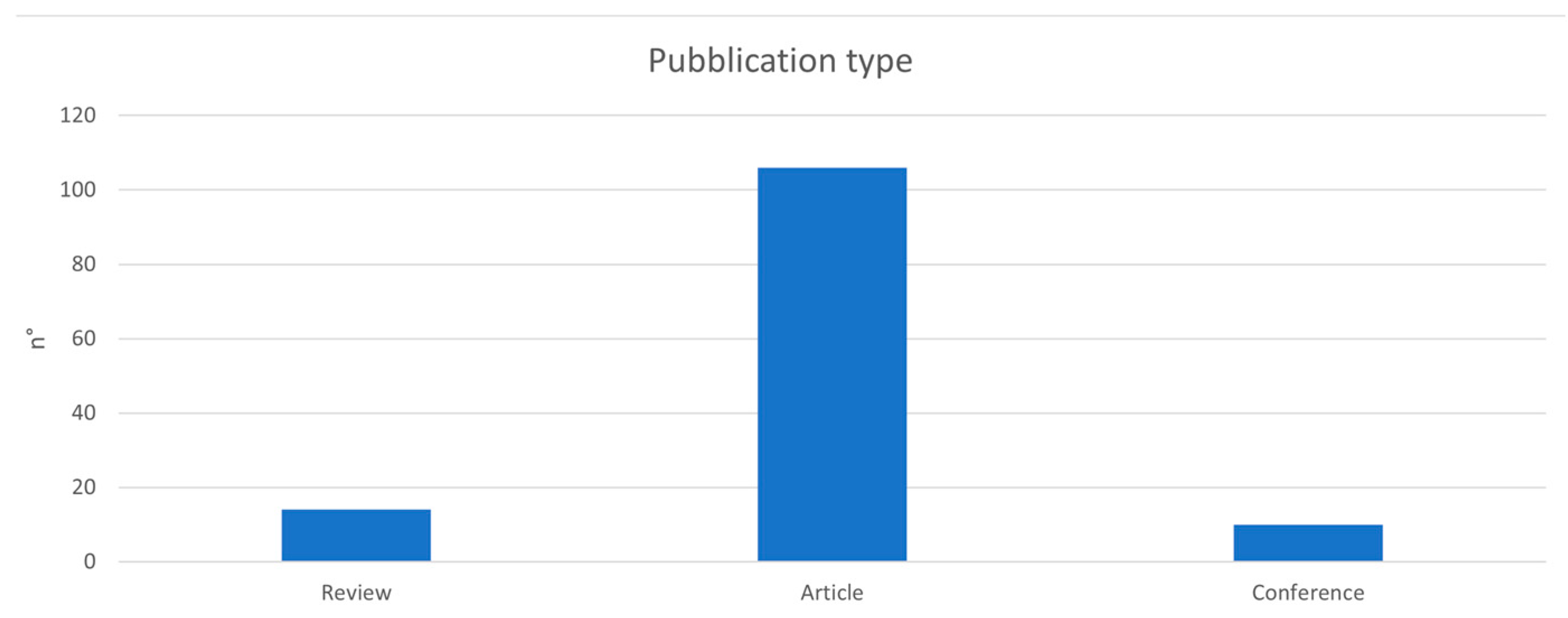
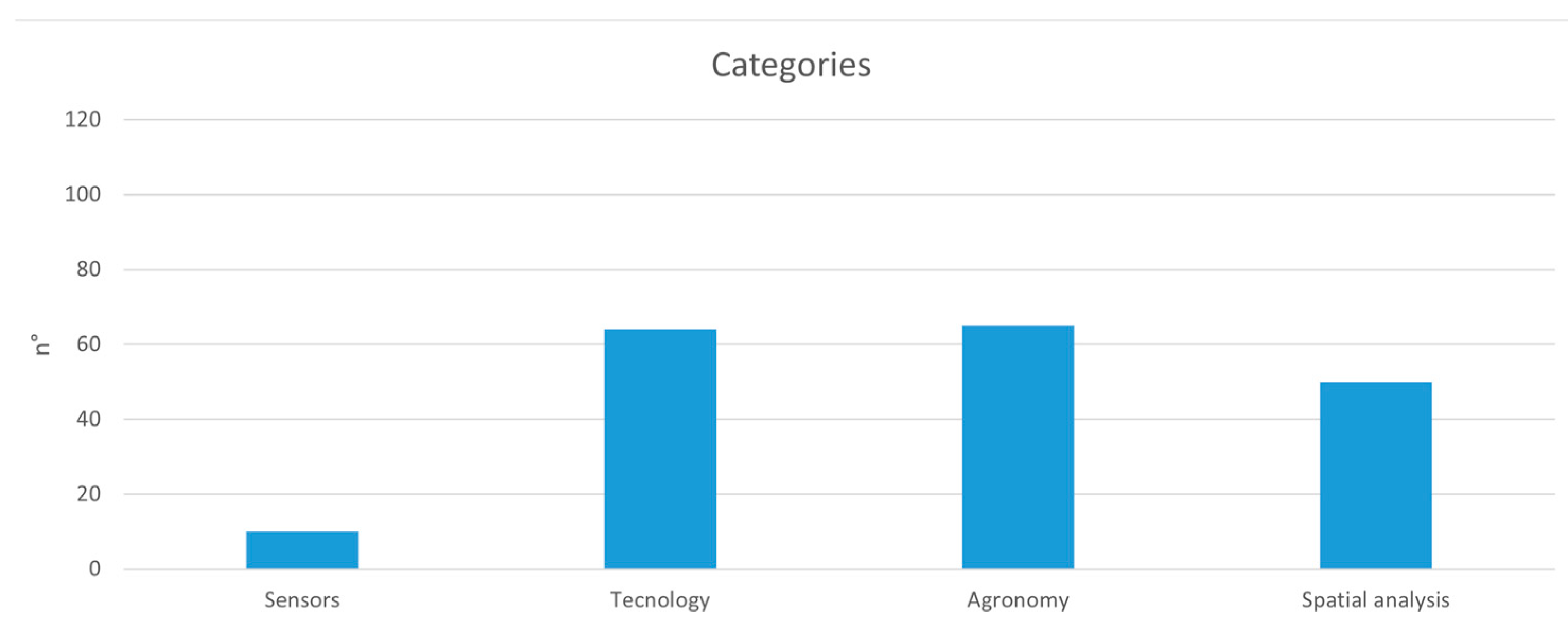
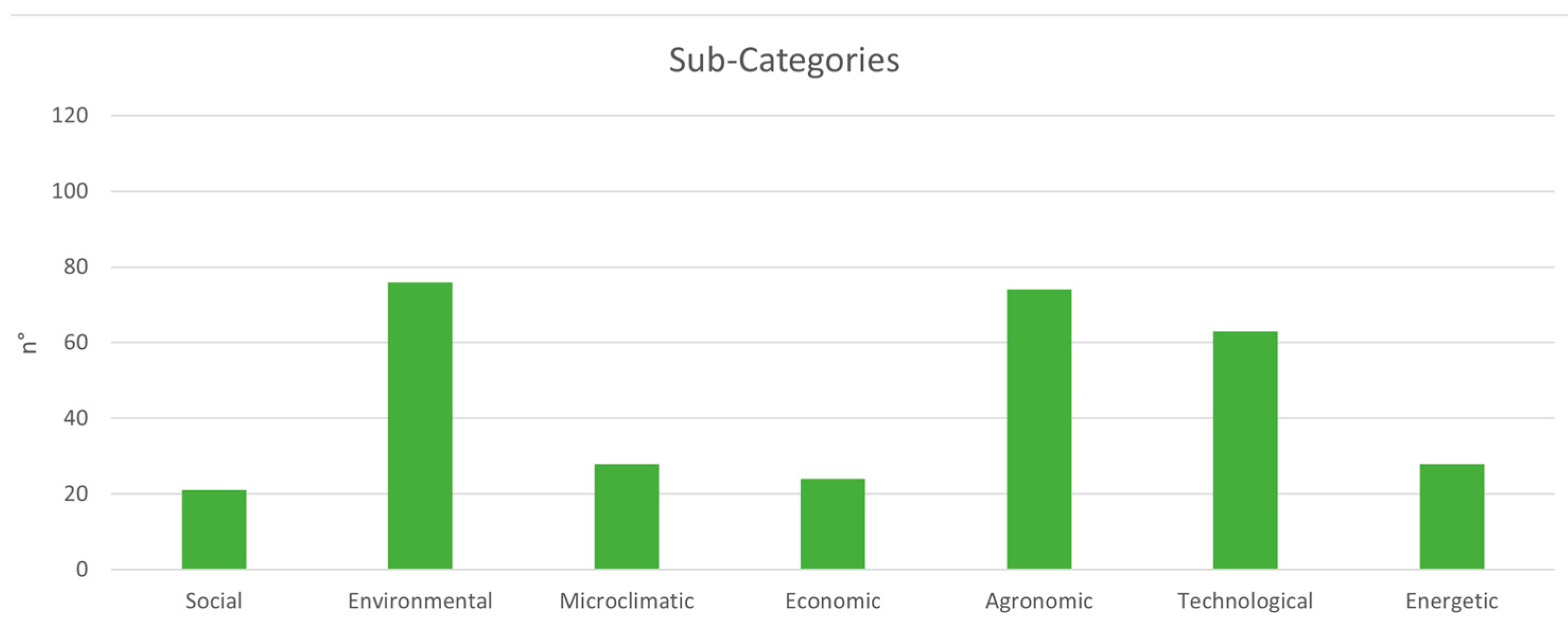
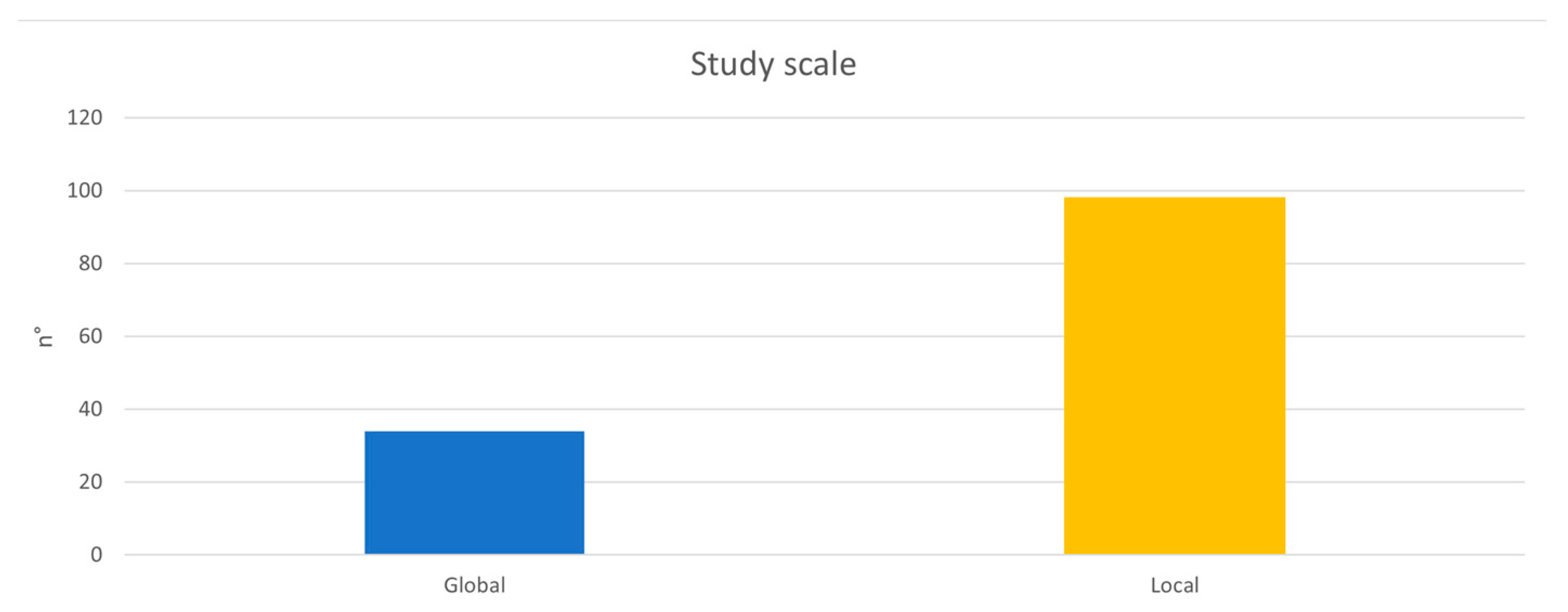
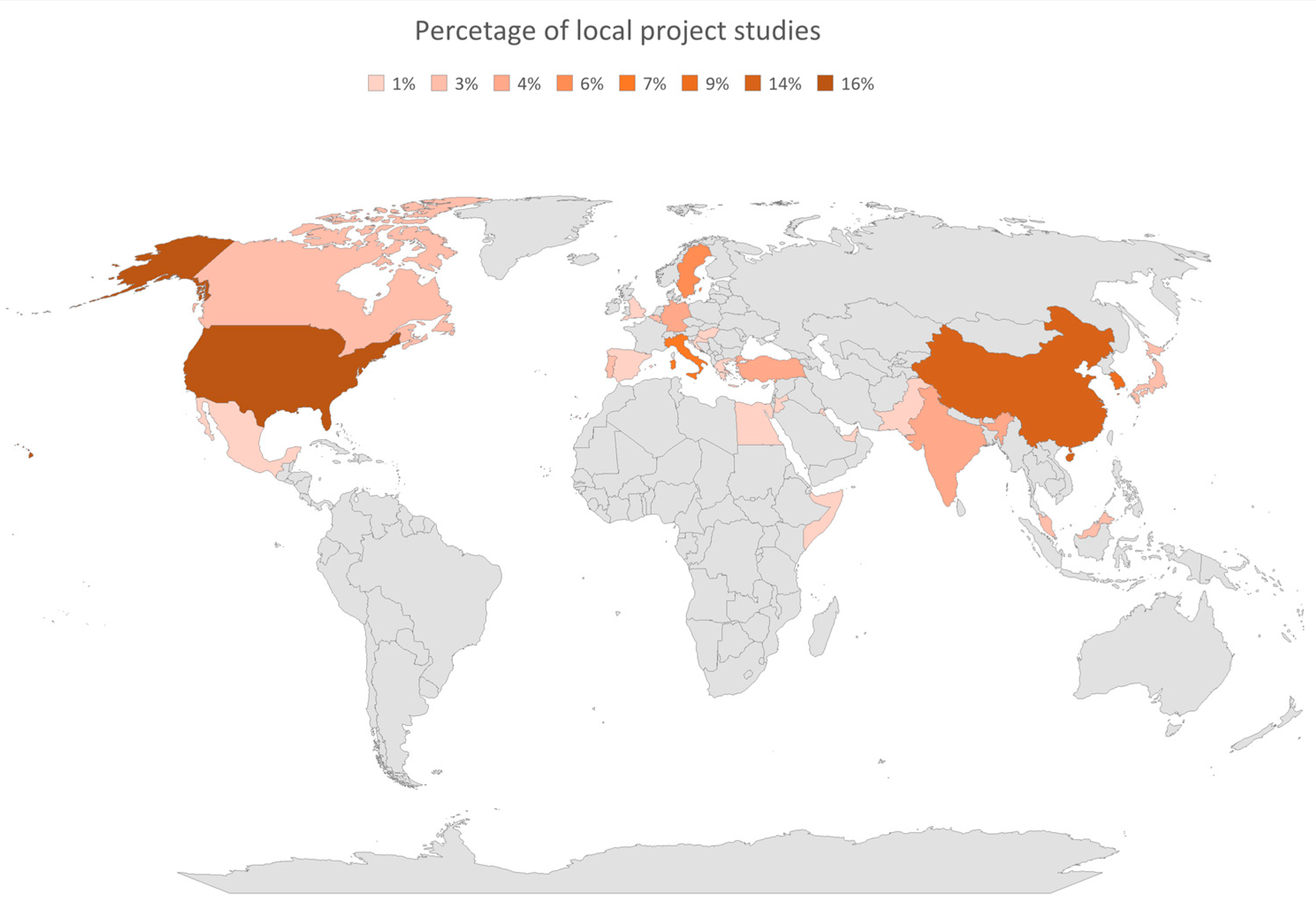
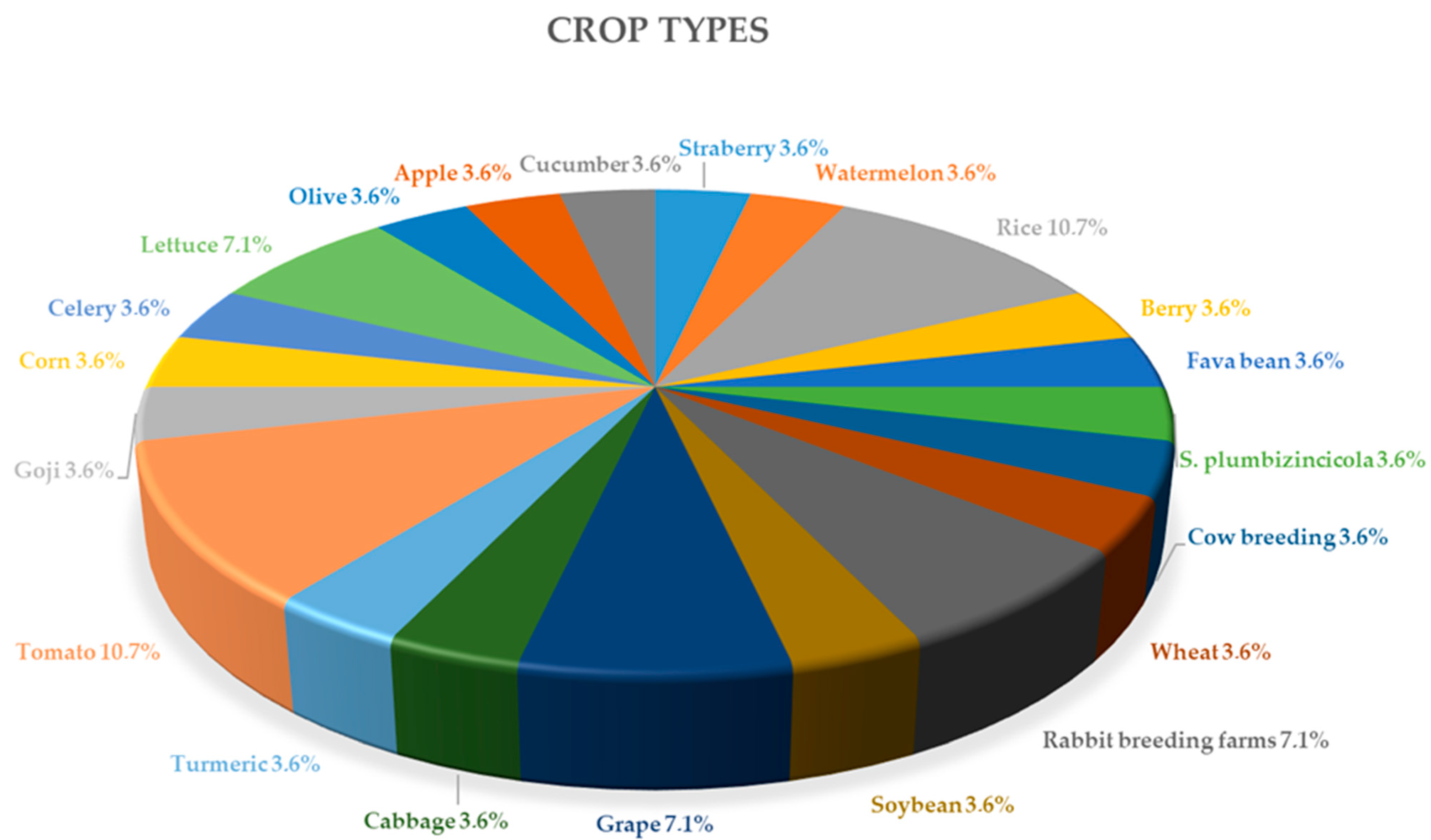
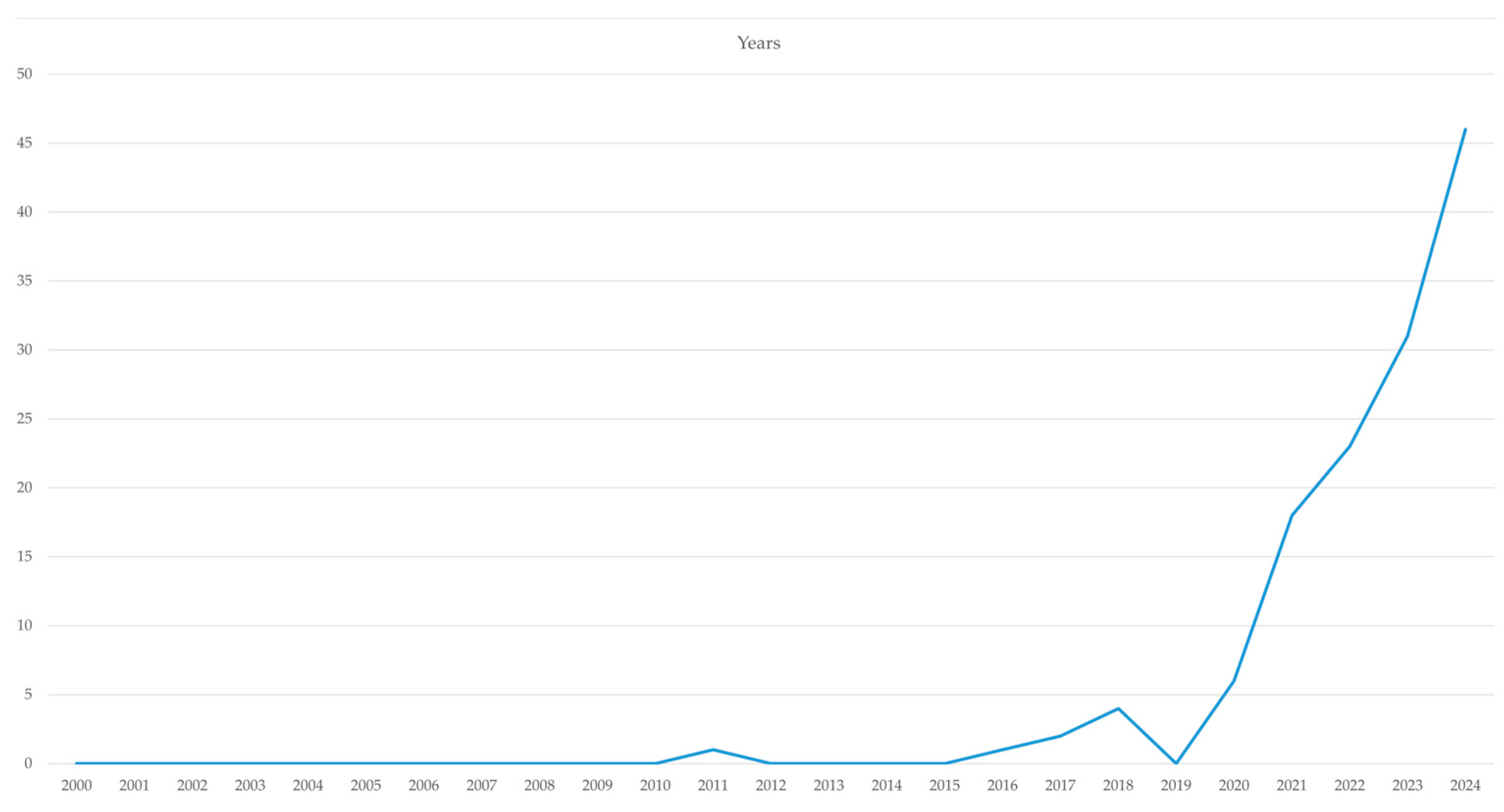
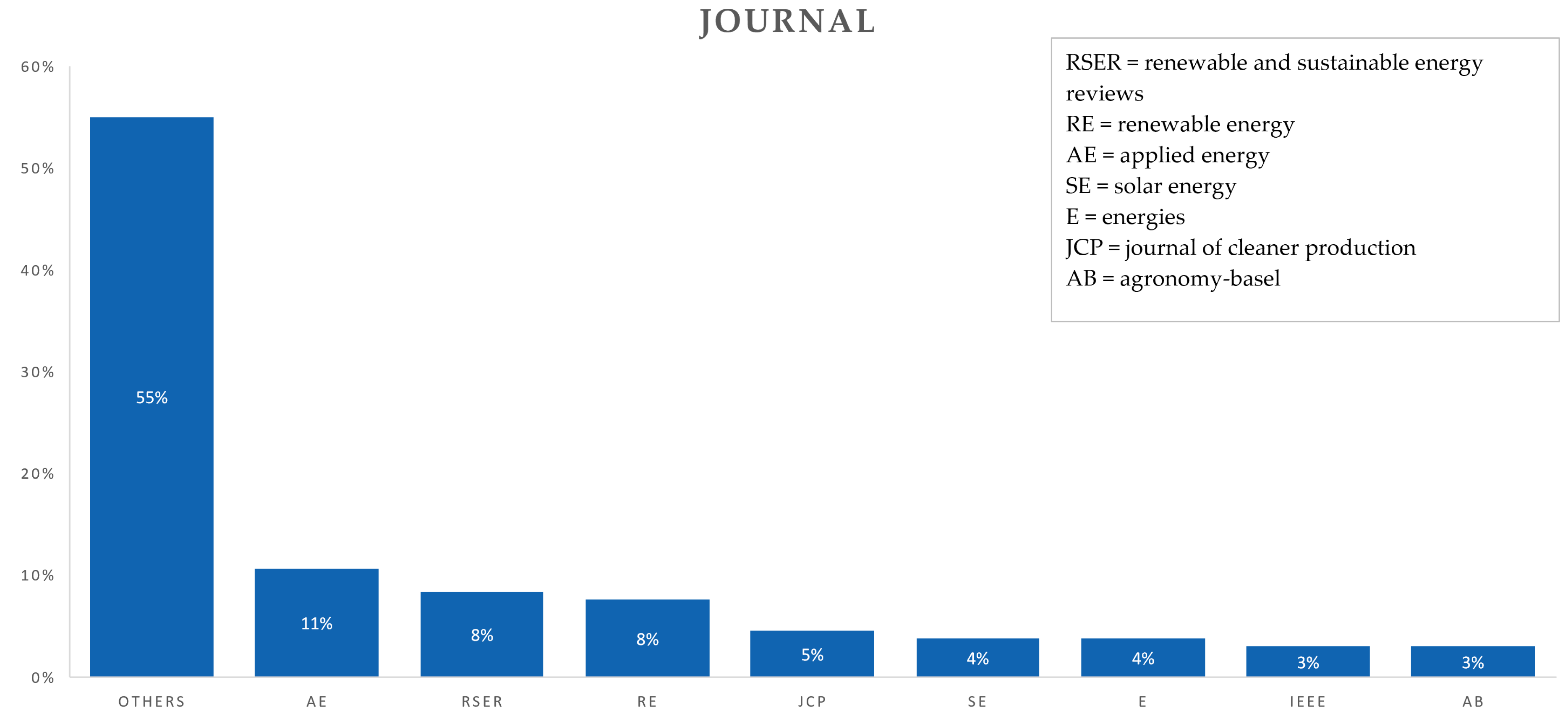
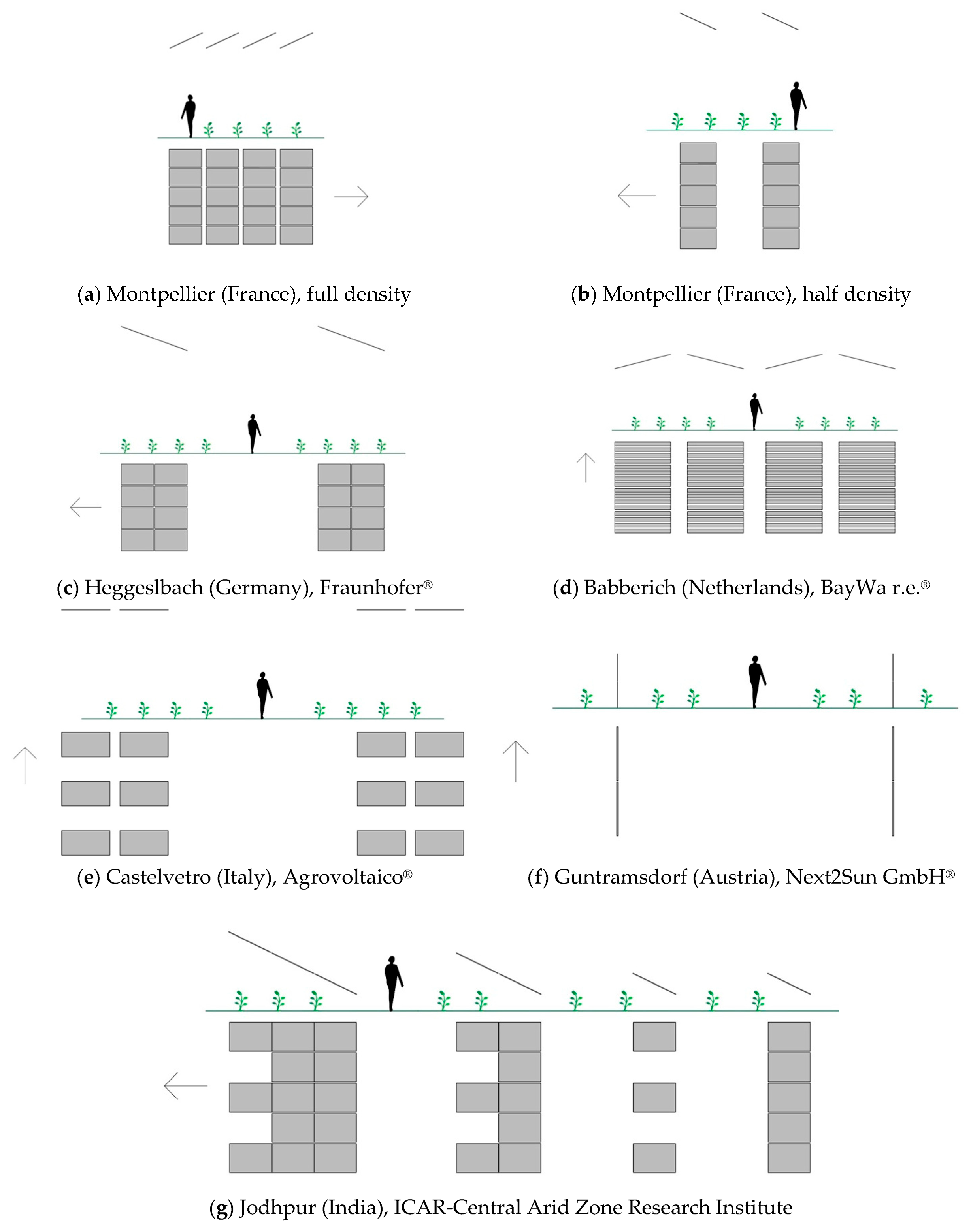
| Identification | Screening | Total | |
|---|---|---|---|
| Web of Science | 159 | 58 | 132 |
| Scopus | 125 | 54 | |
| Scholar | 22 | 20 |
| Technology | Description | Efficiency | Transparency | Annual Degradation Rate | Cost | AVS Compatibility | Citations | |
|---|---|---|---|---|---|---|---|---|
| Photovoltaic system | Traditional fixed panels | Static installations, easy to install. | 15–22% | variable by layout | 0.3–1% | + | + | [48,49,50,67] |
| Vertical double-sided panels | They collect light on both sides, using both direct and reflected light. | 10–20% | variable by layout | 0.3–1% | ++ | ++ | [48,51,52,53] | |
| Tracking systems | They maximize energy production during the day. | 15–30% | variable by layout | 0.3–1% | ++ (single axis) | ++ | [54,55,56] | |
| +++ (double axis) | ||||||||
| Greenhouses | They optimize harvests with a regulated microclimate | 5–15% | variable by layout | 0.5–1% | ++++ | +++ | [57,58,59,63,64] | |
| Photovoltaic panels | Monocrystalline | Produced with a single crystal of silicon | 18–22% | ~0% | 0.3–0.7% | ++ | + | [48,49,67,68] |
| Polycrystalline | Produced by fusing fragments of silicon crystals | 15–17% | ~0% | 0.4–0.8% | + | + | [50,56,67,68] | |
| Organic (OPV) | Based on conductive polymers or small organic molecules | 5–15% | 20–50% | 1–3% | +++ | ++ | [60,61,69] | |
| Semi-transparent | Made from advanced materials such as amorphous silicon | 15% | 20–40% | 0.5–1% | ++++ | +++ | [50,60,61,62,63,69] | |
| Beam-splitting | They separate wavelengths. | upgrade of 5–15% | selective transparency | 0.5–1% | +++++ | + | [65,70] | |
| Organic thin layer | They combine organic and inorganic materials. | 5–15% | 50–90% | 1.5–4% | ++++ | +++ | [57,69] |
| Parameter | Description | U.M. | Cost | AVS Compatibility | Degree of Expertise Needed | Citations | |
|---|---|---|---|---|---|---|---|
| Environmental Monitoring | Moisture | Ambient humidity | % | + | ++ | + | [134] |
| Temperature | Ambient temperature | °C | ++ | +++ | + | [54,56,134] | |
| Wind | Wind speed and direction | m/s; “°” | ++ | +++ | + | [54,56,134,140] | |
| Solar radiation | Solar radiation on the ground | W/m2 | ++ | +++ | + | [54,56,134] | |
| Irrigation monitoring | Electrical Conductivity | Water salinity | dS/m | ++ | ++ | + | [141,142] |
| pH | Hydrogenionic potential | n/a | + | +++ | + | [141,142] | |
| Water temperature | Irrigation water temperature | °C | ++ | +++ | + | [134,141] | |
| Soil monitoring | Nitrogen (N) | Nitrogen levels for vegetative growth | mg/L, ppm | ++ | ++ | ++ | [143,144] |
| Phosphorus (P) | Phosphorus for root development | mg/L, ppm | ++ | ++ | ++ | [143,144] | |
| Potassium (K) | Potassium for stress resistance | mg/L, ppm | ++ | ++ | ++ | [143,144] | |
| Soil salinity | Salinity control for optimal absorption | dS/m | ++ | ++ | ++ | [145] | |
| Soil aeration | Porosity for gas exchange and roots | % | ++ | ++ | ++ | [146] | |
| Microelements | Availability of trace elements for metabolism | mg/L, ppm | ++ | ++ | ++ | [146] | |
| Methods and tools for monitoring | Vegetation indices | Information on the health, density and vigor of the vegetation. | n/a | + | ++ | +++ | [134] |
| IoT integration and real-time analysis | Networks of physical devices, sensors, software and other technologies | n/a | +++ | +++ | +++ | [44,66] | |
| Computational Fluid Dynamics models | Microclimate optimization with CFD models | n/a | +++ | +++ | +++ | [50,135] | |
| PAR | Direct/diffuse PAR models for plants | n/a | ++ | ++ | +++ | [136,137] | |
| GCR | Ratio of module area to land area | n/a | + | ++ | ++ | [138] | |
| Drones | Plant health monitoring with detailed images | n/a | ++ | +++ | +++ | [139] |
Disclaimer/Publisher’s Note: The statements, opinions and data contained in all publications are solely those of the individual author(s) and contributor(s) and not of MDPI and/or the editor(s). MDPI and/or the editor(s) disclaim responsibility for any injury to people or property resulting from any ideas, methods, instructions or products referred to in the content. |
© 2025 by the authors. Licensee MDPI, Basel, Switzerland. This article is an open access article distributed under the terms and conditions of the Creative Commons Attribution (CC BY) license (https://creativecommons.org/licenses/by/4.0/).
Share and Cite
De Francesco, C.; Centorame, L.; Toscano, G.; Duca, D. Opportunities, Technological Challenges and Monitoring Approaches in Agrivoltaic Systems for Sustainable Management. Sustainability 2025, 17, 634. https://doi.org/10.3390/su17020634
De Francesco C, Centorame L, Toscano G, Duca D. Opportunities, Technological Challenges and Monitoring Approaches in Agrivoltaic Systems for Sustainable Management. Sustainability. 2025; 17(2):634. https://doi.org/10.3390/su17020634
Chicago/Turabian StyleDe Francesco, Carmine, Luana Centorame, Giuseppe Toscano, and Daniele Duca. 2025. "Opportunities, Technological Challenges and Monitoring Approaches in Agrivoltaic Systems for Sustainable Management" Sustainability 17, no. 2: 634. https://doi.org/10.3390/su17020634
APA StyleDe Francesco, C., Centorame, L., Toscano, G., & Duca, D. (2025). Opportunities, Technological Challenges and Monitoring Approaches in Agrivoltaic Systems for Sustainable Management. Sustainability, 17(2), 634. https://doi.org/10.3390/su17020634









